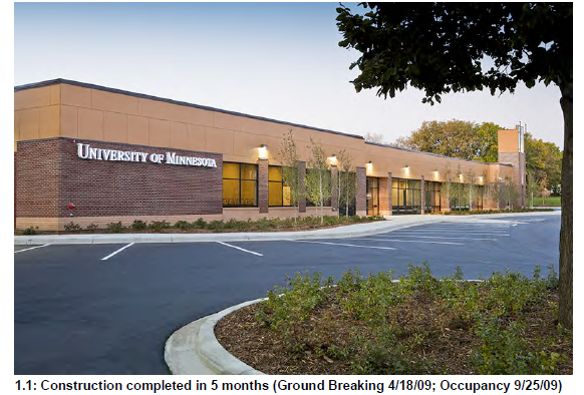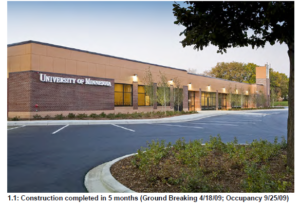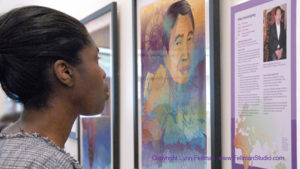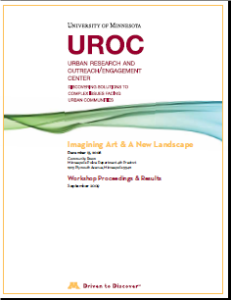- May 17, 2020
- Posted by: Irma McClaurin
- Categories: Blog, Community Engagement

 I have been actively engaged in community engagement as an anthropologist and also as an administrator for decades. The opportunity to put into real practice what I had learned over time came in late 2007, during my role as the Associate Vice President and Founding Executive Director of the University of Minnesota’s (UMN) first Urban Research and Outreach Engagement-Center (UROC). UROC began as an “urban agenda,” and it became my responsibility (and my passion) to make transform it into an “urban vision for the 21st Century” of community engagement.
I have been actively engaged in community engagement as an anthropologist and also as an administrator for decades. The opportunity to put into real practice what I had learned over time came in late 2007, during my role as the Associate Vice President and Founding Executive Director of the University of Minnesota’s (UMN) first Urban Research and Outreach Engagement-Center (UROC). UROC began as an “urban agenda,” and it became my responsibility (and my passion) to make transform it into an “urban vision for the 21st Century” of community engagement.
This year (2020) marks the tenth year anniversary of the launch of UROC, a University research center based in an urban community in North Minneapolis. There was no doubt in anyone’s mind that the Northside community was in need of support. It was one of the most under resourced area of Minneapolis. And every time a major financial crisis hit nationally or locally, North Minneapolis suffered.
In 2007, I was hired by the University of Minnesota as an Associate Vice President and founding Executive Director to work on the development of UROC. Through my work as an anthropologist since 1991, I was deeply grounded in participatory research, rapid assessment approaches to data collecting, and other methods in which those being studied became part of the research process…i.e., co-creators. And my own ethics, as a woman and “native” anthropologist, required that I be intentional about my involvement, and not make any assumptions. It also required that I suspend my power role as “expert.”
Over the course of 15 months, the time it took to build trust from the ground up, after 2 1/2 years of conversations (prior to my arrival) that had yielded little change, and catalyzed the community to protest UMN’s impending presence at a Board of Regents meeting, they were ready for action. The Northside community challenged the UMN’s plan to conduct research that might involve children, often invoking the Tuskegee syphillis experiment as an example of how scientists and science could not be trusted. They wanted to hold UMN, its students, and its faculty accountable for demonstrating the direct benefit of any research project to the community. As a result, the University-Northside Partnership was formed as the beginning. The next stage was identifying a space for the first Urban Research and Outreach Center in North Minneapolis and involving community in every aspect of UROC’s development. The University purchased a derelict 1970’s , 21,000 sf strip shopping center in North Minneapolis.
Without the support of the two lead architects, Alicia Belton of Urban Design Perspectives and Charles Levin of Charles Levin Architects, and the 15 member team they assembled that included public artist, Setiu Jones, and Bob Close, an environmental landscaper, along with the usual engineers, etc, UROC would not be the special space it is today. It has an art gallery in the reception area, community classrooms, and business hoteling space for start-ups.


The current UROC website, unfortunately, does not currently contain all the background material it once had. UROC was initially conceived of as a “demonstration project” and so its website once held all the archives of news coverage (positive & negative), examples of the process by which the community was deeply involved in the development of UROC’s strategic plan, and even participated in helping to shape the design of the renovated space.
 Hopefully, this archive of community involvement will be restored. It is an important part of UROC’s history. This project was not the result of the University of Minnesota’s altruism but rather it was the direct result of community resistance, push back, and involvement. Early on, I had the staff maintain all documents, press releases, and news articles (bad or good) on the website so that visitors could understand the process of how we achieved the goals we did.
Hopefully, this archive of community involvement will be restored. It is an important part of UROC’s history. This project was not the result of the University of Minnesota’s altruism but rather it was the direct result of community resistance, push back, and involvement. Early on, I had the staff maintain all documents, press releases, and news articles (bad or good) on the website so that visitors could understand the process of how we achieved the goals we did.
After my departure, and with the new leadership, vestiges of my involvement were erased. I am not honored in the portrait gallery, though I provided the leadership, in collaboration with the community, that spearheaded the development of UROC from the ground up. I oversaw the building renovation, upon completion developed the operations plan, and selected every wall color, carpet treatment, furniture, and can tell you how many HVACs are on the roof. I know the intimate details of the building’s wiring because I approved every single detail. Try as they might, it is hard to erase my contribution. Upon completion, UROC was named a finalist in the “Best of Real Estate” Awards in 2009.
I think, however, the most blatant erasure is that of the community’s challenging the University of Minnesota. Without the documentation of community involvement, the current website gives the appearance that the UMN was altruistic, when the truth is the Northside community waged a community campaign of outrage and pressure. Community engagement is messy, and that needs to be visible to all.
As the founding leader, I am proud of some the unique things I accomplished. One was serving as the coauthor of a $2.9M American Recovery and Reinvestment Grant (ARRA) from the Department of Commerce to design a Broadband Access Program that included job creation. To its credit, the University of Minnesota contributed $770,000. The beneficiaries were 11 community computer centers (not in schools or libraries, since these institutions are based in the community, but are not of the community).
A second accomplishment was bringing art into the mix by commissioning UROC’s first community-based permanent art collection consisting of DNA Art by then Minneapolis artist Lynn Fellman.  The project involved Fellman working with the community nonprofit Juxtaposition Arts and taking on two youth apprentices. She also collaborated with other community organizations to identify the individuals they wished to have included in the exhibit: “Genetic Ancestry: Diversity of a Community.” The North Minneapolis also knows what I contributed.
The project involved Fellman working with the community nonprofit Juxtaposition Arts and taking on two youth apprentices. She also collaborated with other community organizations to identify the individuals they wished to have included in the exhibit: “Genetic Ancestry: Diversity of a Community.” The North Minneapolis also knows what I contributed.
UROC represented a unique opportunity to build a community-based research center in an under served community while practicing authentic community engagement. The community got to have input on the architectural plan, which was documented in a workshop entitled “Imagining Art and the New Landscape.” 
It is a decade since I left the University of Minnesota, and I have new found ways to continue to put into practice many of the community engagement lessons I learned. First and foremost, I have come to let go of the need to always center myself as “the expert.” I have learned to listen to the community, where ever I am, analyze the historical and cultural contexts of the places where I work, and then figure out what action to take, in consultation with the community leaders. As a consultant, I ask myself “What do they really need that I can offer?”
Towards a Participatory Engagement Methodology
This process of unlearning my power and privilege as a researcher began when I conducted my first fieldwork in Belize, Central America in 1991. The data I collected was used to complete my dissertation that became the book, Women of Belize: Gender and Change in Central America (2000 [1996]). During that period of ethnographic fieldwork and participatory research and community engagement, I lived and worked with mostly rural women and came to realize that they understood their own subordination far better than I had anticipated. And, while they might not always take action, many had a deep awareness of the personal, economic, and social constraints under which they lived. 
I gained this insight not by just dropping in (notebook & pen in hand) and “studying” them. Instead, I worked along side them as an equal (a seamtress), ate meals with their families, and hung out with them on the weekends dancing to the local punta music, reggae, and some dance hall. It became a standing joke among the women, “tap a pan, Irma dance.”
The process of becoming an “observant participant” prepared me for the work at UROC. I approached it as an anthropologist would, telling people that I had one foot in the University and one foot in the community. Ironically, while I was able to transform critics in the community into supporters, some of my strongest opposition came from my colleagues inside the University.
Practicing Authentic Community Engagement
Sometimes my support and advocacy for the community’s perspective and involvement was viewed as challenging the University. I was accused of “not watching” my boss’ back. And yet, despite the challenges, being able to translate the idea of UROC into a reality that would benefit the community was well worth the cost. I remain connected to the place/space of UROC, and to the people of North Minneapolis. 
The first stage of my evolution was learning to recognize the difference between community engagement/public engagement and “authentic” community engagement. Often, academic scholars and administrators had a difficult time disengaging from their roles as experts and authority and positions of power to recognize that community members, who might not have the same level of education, certainly had valuable ideas to offer, could generate solutions, and as anthropologist John Gwaltney once observed in his seminal book, Drylongso, are involved in “theory building” every day.
Authentic community engagement is not easy. According to “A Preliminary Matrix for Evaluating Reciprocity within Community/University Partnerships, North Carolina Campus Compact, Feburary 12, 2008,” it requires a recognition that the two entities (in this case the University and the community) have a joint destiny, that the destinies of the institution and the community’s are intertwined, and that they must fully cooperate to achieve the desired outcome.
One of the general failures that turn supposed collaborations into consultancies is that the institutional representative often meet before hand to plan their strategy. In doing so, they make decisions and form opinions about the outcomes before ever meeting the community. This places them in positions of power, who simply want the community to cosign or rubber stamp what they have already decided, making the community consultants instead of collaborators. As difficult as it might be, both sides need to come to the situation at hand without an agenda, identify what the core issues are that can be agreed upon, and brainstorm solutions.
Trust is a process, and it will take time. I have found that going to the community instead of them coming to the university began to break down some of the “them” v. “us” mentality. Also beforehand, those with power have to be clear that they will give up something, and ask the hard question of how much are they willing to relinquish–at the end of the day, collaboration is all about compromise.
Authentic Community Engagement is my life’s work. In 2019, I had the chance to apply this approach to community engagement as a Community Engagement Specialist for planningNext on the City of Durham’s Comprehensive Plan.

While that work has now ended, what I observed was similar to what I learned almost a decade ago, and that is under served and marginal communities want to be heard and want to trust those who reach out to them. They simply want to be included.
 This year, I have been involved in a development of an exhibit to honor women in Rochester, NY that is community-curated. How to ensure diverse communities are represented has been one of the foundational pieces of my work as one of three Diversity and Inclusion Consultants. Because of the process they have undertaken, the Rochester Museum and Science Center (RMSC) is setting a new standard for how museums can become more inclusive in their programs and in how they engage with community. The exhibition, The Changemakers: Rochester Women Who Changed the World, is scheduled to open in October, 2020. It will be extraordinary, but even more significant because of the work that was done behind the sciences to put into practice the principles of authentic community engagement.
This year, I have been involved in a development of an exhibit to honor women in Rochester, NY that is community-curated. How to ensure diverse communities are represented has been one of the foundational pieces of my work as one of three Diversity and Inclusion Consultants. Because of the process they have undertaken, the Rochester Museum and Science Center (RMSC) is setting a new standard for how museums can become more inclusive in their programs and in how they engage with community. The exhibition, The Changemakers: Rochester Women Who Changed the World, is scheduled to open in October, 2020. It will be extraordinary, but even more significant because of the work that was done behind the sciences to put into practice the principles of authentic community engagement.
Watch the virtual announcement for the Changemakers.
(c) 2020 Irma McClaurin
Irma McClaurin (https://irmamcclaurin.com) is an award-winning writer, consultant, anthropologist, community engagement and DEI specialist, and leadership coach who is a past president of Shaw University.
Community Engagement, Community Engagement And Accountability, Community Engagement Approaches, Community Engagement Definition, Community Engagement Evaluation, Community Engagement Tools
